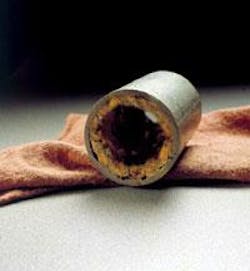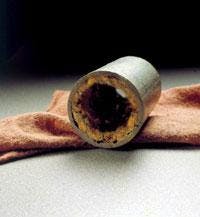Inspection, Cleaning Key to Boiler Performance
By Kenneth Burns and Mike Miller
Modern high-pressure boilers evaporate several million pounds of water per hour. In use 24 hours a day, seven days a week, this results in tremendous rates of evaporation. If the water delivered to the boilers contains even small amounts of scale-forming materials, the internal heating surfaces of the boilers can soon become coated with scale, leading to overheating and subsequent tube failures.
For this reason, cleaning the interior of steam generator systems regularly is imperative. Doing so will remove excessive waterside deposits that may consist of corrosion products, mineral scale, sludge or such process contaminants as calcium, magnesium, copper, iron and silica.
In addition to minimizing failures, removing these contaminants has many other benefits. Regular and thorough cleaning can reveal the boiler metal's true condition and restore the boiler's energy-efficiency.
When, How to Clean
In deciding whether to chemically clean a boiler and with which cleaning method, consider the following:
• The characteristics and quantity of deposit;
• Steam generator design type, flow, operating temperature and pressure;
• The compatibility of the cleaning solvent with the metallurgy of the system;
• Method of spent solvent disposal;
• The ease of application; and
• Cost.
To remove most internal deposits, make a cleaning solution from mineral acids, organic acids or chelants. Then select one of the two basic cleaning methods – circulation or static. In the circulation method, the cleaning solution is continuously circulated to the unit until the solution's acid or iron content becomes constant, which indicates the end of the reaction between the solvent and deposit. In the static method, the cleaning solution soaks in the unit for a prescribed length of time; this method is typically used where circulation of the cleaning solution cannot be accomplished.
Chemically cleaning the waterside or mechanically cleaning the fireside on a regular basis will improve the boiler's technical and economic performance. The former will also significantly reduce deposit buildup. However, some buildup may continue to form, as variations in water treatment system operations, chemical treatment program control or other environmental factors can affect water chemistry.
To help schedule a chemical cleaning, examine the boiler while in operation and also look at it internally. If upsets occur between chemical cleanings, the boiler needs to be cleaned earlier than scheduled.
Assessing Efficiency
When a boiler is operating inefficiently, it provides several clues as to what is occurring internally. The boiler may be suffering from inadequate heat transfer, or it may require chemical (waterside) or mechanical (fireside) cleaning.
For performance trends, compare current results to previous efficiencies. The most exact comparisons are when a boiler is new or after a complete cleaning and overhaul. (A complete cleaning includes both the fire- and waterside applications.)
Another, more in-depth method used for monitoring boiler efficiency is called the "input-loss method." This method follows the ASME guidelines of monitoring where losses occur and requires both flue gas and fuel analyses. The input-loss method allows for correcting the losses and achieving better efficiencies.
Loss Analysis
Inside the boiler, the largest losses occur from heat rising up the flue gas stack and from unconsumed fuel combustibles. Many losses directly reflect on the boiler's operation and maintenance history, including:
• Waterside scale buildup (poor blowdown and /or poor water treatment practices);
• Fireside fouling (improper soot blowing);
• Insufficient heat transfer flow (defective baffles);
• Inadequate convection heat transfer (improper draft);
• Incomplete fuel combustion (poor atomizing / pulverization of fuels, or overfiring of the boiler); and
• Improper air-to-fuel ratio, heat leaks from improper insulation, steam/ water leaks in the boiler and/or associated piping, or worn-out refractories (poor maintenance).
To identify possible heat losses, monitor efficiency calculations and review past results. Then decide which corrective action to take. If efficiency monitoring reveals a downward trend, evaluate waterside deposits by using visual inspection, tube sampling or other methods.
Visual inspection and tube sampling are the two most common analysis methods. Visual inspection is simply any nondestructive means of evaluating the boiler internals. Tube sampling involves removing a section of tube (typically 2 ft), determining the deposit weight density and analyzing the deposit. Of the two methods, tube sampling will provide the best insight into the downward trends.
After determining the amount and type of deposit, use static and/or dynamic tests to help choose the appropriate cleaning chemistries. It is important to select cleaning chemistries that will remove the deposit without damaging the boiler tube's base metal. Then assess associated economic, safety and environmental factors, develop the procedure and finally, implement the job.
Conclusion
To reduce how frequently a steam generation system needs to be chemically cleaned, it is important to properly maintain and operate the boiler feedwater treatment system and control the boiler water chemical treatment program. When deposits build up, a boiler cleaning is necessary. Cleanings occur more frequently as the system's operating pressure increases.
Having a trained professional chemically clean the system is important and ensures safe operation at the boiler's peak performance. This becomes even more essential to cost-effective facility operations, especially as energy costs continue to rise.
About the Authors
Kenneth (Ken) Burns is a project manager in the Technical Services and Research Facility at Onyx Industrial Services. Based in Alvin, TX, Burns supports the pulp & paper and power markets. He has worked in the industry for more than 16 years, spending half of that at Onyx. Mike Miller is vice president of the pulp & paper market at USFilter. Miller manages the pulp & paper sector for USFilter as well as for Onyx. He joined USFilter nine years ago and has worked in the environmental industry for 25 years.

